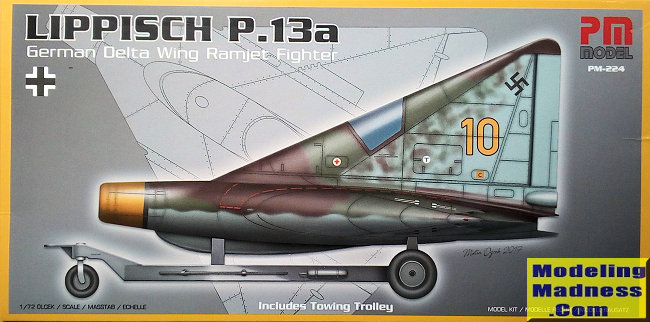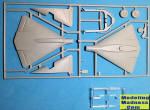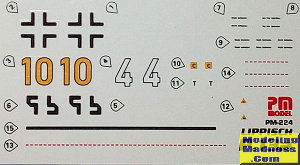
PM 1/72 Lippisch P.13a
| KIT #: | PM 224 |
| PRICE: | €5.00 |
| DECALS: | Two options |
| REVIEWER: | Spiros Pendedekas |
| NOTES: | 2019 reissue with updated decals and instructions |

| HISTORY |
During 1942, while still working on the Messerschmitt Me 163 rocket fighter, Dr. Alexander Lippisch developed a sharply-swept, leaf-shaped delta wing interceptor which he believed was capable of supersonic flight. Out of this and subsequent development of the P.11/Delta VI "power wing" through 1943 and early 1944, he conceived the idea of a hollow delta wing with its interior shaped like a ramjet duct. The futuristic design would carry no armament, but would be heavily reinforced in order to ram its opponent.
Initially conceived as a disposable machine with the pilot bailing out at the end of the mission, a landing skid was later added. Launch to ramjet operational speed would be via catapult and/or booster rockets.A variant with a rectangular canard foreplane was wind-tunnel tested and conventional gun armament was also being considered.
The P.13 featured a large fin and integral raised cockpit. The wing trailing edge was angled slightly forwards. The outer wing sections could be folded upwards for transportation by rail.
As conventional fuels were in extremely short supply by late 1944, Lippisch proposed that the P.13a be powered by alternative fuels, such as various types of coal, or pine wood heat-soaked in oil or paraffin. Lippisch soon came to conclude that this might even be more effective than liquid fuels, as the location of combustion was more precisely controllable.
The P.13a had reached a stage where full-scale aerodynamic trials would be possible. A glider with the same general design and 22 ft wingspan, but with the intake and exhaust faired in, was built as the DM-1. Lippisch however took little interest and,having moved on from the design, he set up the glider project only to keep students of Darmstadt and Munich Universities from being drafted into a by-then hopeless war.
The DM-1 had not been finished when it was captured by American forces and the Americans ordered Lippisch's team to complete the glider, which was then shipped to the United States where it was test flown. According to the National Advisory Committee for Aeronautics (NACA) the results were positive and lessons learned were incorporated into NASA's research aircraft of the 1950s and on.
| THE KIT |
 PM
came in 2004 with a mainstream kit of the P.13a, the only other 1/72
option till then being the 90s RS resin kit. The PM kit has been recently
reissued (2019) with updated decals and instructions, which is the subject of
this preview.
PM
came in 2004 with a mainstream kit of the P.13a, the only other 1/72
option till then being the 90s RS resin kit. The PM kit has been recently
reissued (2019) with updated decals and instructions, which is the subject of
this preview.
It comes in a good quality side opening small box, with a very attractive box
art, featuring a side profile of a P.13a on its trolley. Upon opening the box, I
was greeted with only 10 light gray styrene pieces in a single sprue, of which
the 6 are for the plane and the rest 4 for the trolley. Panel lines are engraved
and no flash is evident. The surfaces are on the pebbly side, something easily
dealt with light sanding.
The fuselage is integrated with the wings and comes as an upper/lower half
affair. Cockpit is simplistic with only a basic looking seat and stick provided,
but little will be visible through the small opening and the clear but thick
canopy. The accompanying trolley is also looking good and its one piece wheels
are a nice touch.
Instructions come in a three-folded A4 pamphlet and are very nicely
color-printed in a good quality paper. They feature a small history of the
project, with the very simple construction spread in 4 very clear steps. No
internal color callouts are provided, but, since it is a projected plane, you
may either go with (easily found at the net) standard RLM practices or
improvise!
 Two very
attractive what-if schemes are provided, for a “Gelb 10” or “Weiss 4” bird. Camo
drawings are nice and colors, apart from generic names, are given in Humbrol,
Tamiya, Modell Master and FS codes. Decals look superbly printed and include
swastikas. Of course, since it is a what-if project, you can go for your own
projected camo!
Two very
attractive what-if schemes are provided, for a “Gelb 10” or “Weiss 4” bird. Camo
drawings are nice and colors, apart from generic names, are given in Humbrol,
Tamiya, Modell Master and FS codes. Decals look superbly printed and include
swastikas. Of course, since it is a what-if project, you can go for your own
projected camo!
Instructions want you to first join the upper and lower main body parts, then
attach the seat and stick in position. The two piece fin that contains the
cockpit opening is then assembled and attached, followed by the canopy and
finishing with the trolley assembly, for what definitely is a simple and
seemingly uncomplicated build.
| CONCLUSIONS |
This is an attractive (and so far the
only 1/72 mainstream) kit of the P.13a project: though basic in detail
(something that in the specific case practically affects only the cockpit), it
is well molded, promising to provide a good representation of the projected
plane.
Construction could not be simpler (but bear in mind that “simple” might not
always mean “easy''...), instructions are nice and decals look very well done.
The small canopy is on the thick side, and I only hope that PM has corrected it
dimensionally in this newer issue, since it was found too small at our Editor’s build of
the first boxing back in 2003.
Offered at a very low
price and practically suitable for camo experiments (since it is a projected
plane), this simple kit is a good candidate for introducing youngsters to the
magic world of model building.
Happy modeling!
May 2022 Copyright ModelingMadness.com. All rights reserved. No
reproduction in part or in whole without express permission. If you would like your product reviewed fairly and
fairly quickly, please
contact
the editor
or see other details in the
Note to
Contributors.